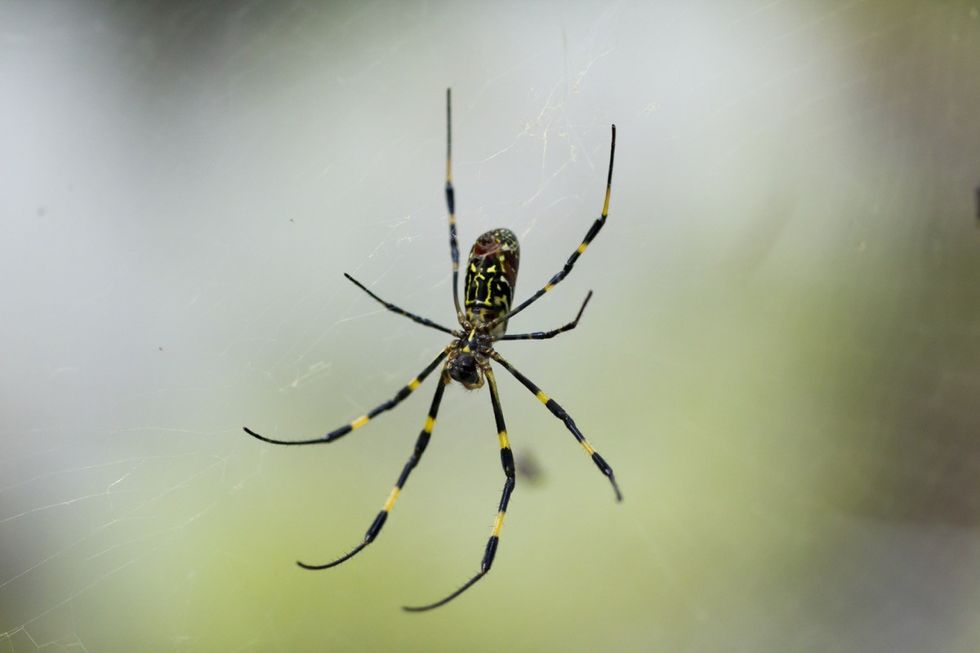Giant spiders that spin enormous webs are the stuff of horror stories—not the type of thing you expect to encounter on the daily (or, uh, ever). The mere fact that they exist is especially unnerving if you're part of the 3 to 15 percent of the population that has arachnophobia. But even if you're not, many of us prefer spiders we can remove from our homes in a simple Tupperware or piece of tissue paper. So, our ears perked up—and our brains freaked out—when we learned that there is an invasive species of spider that's made its way stateside. It has some pretty scary attributes, and experts say it'll probably multiply faster than expected. Read on to learn what scientists think about the arachnids' arrival.
RELATED: "Very Large" New Spider Species Discovered—Here's Where There May Be Hiding.
Jorō spiders don't belong in the U.S.
 Shutterstock / Kelly vanDellen
Shutterstock / Kelly vanDellenThe frightening new spider that's appearing across the country is called the jorō—and it doesn't belong here. According to a 2015 study published in the journal PeerJ, the jorō spider likely arrived in the U.S. via a container ship from an East Asian country like Japan, China, Taiwan, or Korea.
They were first spotted in Atlanta, GA, in the fall of 2014; now, the spider is "fully established" in the state, per the study, so the prospect of eliminating it is nothing more than a pipe dream.
Jorōs aren't the first arachnids to hitch a ride to the States and probably won't be the last. "Spiders, largely due to their secretive habits and ability to hitchhike on various commodities, linked with the speed with which these items are transported to North American ports, can easily be introduced inadvertently into novel habitats," wrote the study authors.
Jorōs are famous for their three-inch bodies and six-foot webs.
 iStock / David Hansche
iStock / David HanscheAllow us to explain the jorō spider: This arachnid is part of a group of spiders called orb weavers since they created "highly organized," yellow-tinted, wheel-shaped webs, according to the pest-control experts at Orkin. The webs can span more than six feet.
The spiders themselves are pretty freaky, too. The females can grow up to three inches, which is twice the size of the males. They have yellow and blue-black abdomens and legs, while the males have a brownish color. The females can lay up to 400 to 1,500 eggs a year. Sometimes, the creatures catch air currents to travel as far as 100 miles, which led some news outlets to call them "palm-sized, flying spiders."
RELATED: Doctors Keep Finding Spiders in People's Ears—These Are the Tell-Tale Symptoms.
They're better suited for city living than experts previously thought.
 iStock
iStockWhile jorōs have been on scientists' radar for a while, a new study published Feb. 13 in the journal Arthropoda found they may be more "urban tolerant" than expected. That means they could appear in more states along the East Coast in addition to Georgia, where they're established, as well as South Carolina, North Carolina, Tennessee, Alabama, Maryland, Oklahoma, and West Virginia, where there have been sightings.
One thing that has surprised scientists about jorō spiders in the past is that they often live near major highways. Usually, the vibrations caused by vehicles interfere with spiders' ability to hunt. The recent study found that these vibrations impact jorōs less than they impact other spiders.
"I don't know how happy people are going to be about it, but I think the spiders are here to stay," said Alexa Schultz, a study co-author and third-year ecology student at the University of Georgia, in a statement.
The researchers expect to see the spiders in the Northeast soon, they're just not sure when.
They're ultimately fairly harmless.
 iStock
iStockBefore you get too nervous, know that jorō spiders are not harmful to humans. "We have no evidence that they've done any damage to a person or a pet," said Dave Coyle, an assistant professor at Clemson who has a doctorate in entomology and studies the spiders, to CBS News.
Unfortunately, the jury is still out on their impact on the environment. Coyle noted that areas with jorōs tend to have lower populations of native spiders, which could have ramifications.
As of now, the threat is minimal. If you spot a jorō, experts suggest simply killing it or moving it elsewhere.
You may also need to learn to live with them. "If they're literally in your way, I can see taking a web down and moving them to the side," Andy Davis, a research scientist in the Odum School of Ecology at the University of Georgia and author of a 2022 study on jorōs, said in a press release, "but they're just going to be back next year."





